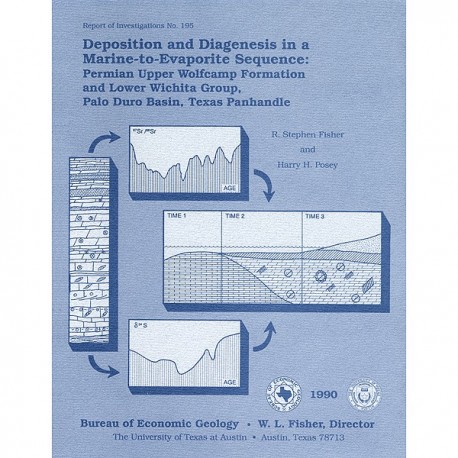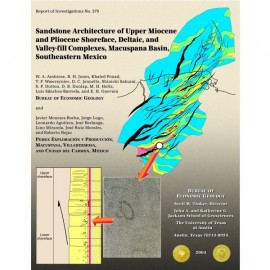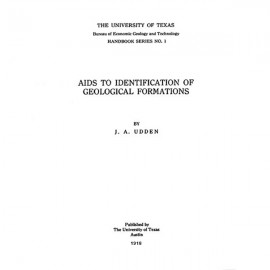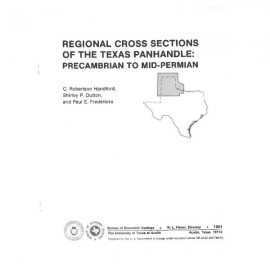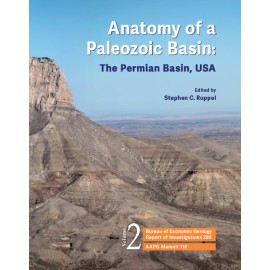Reports of Investigations
-
Books & Reports
- Reports of Investigations
- Guidebooks
- Udden Series
- Geological Circulars
- Down To Earth
- Atlases of Major Oil and Gas Reservoirs
- Texas Memorial Museum Publications
- Environmental Geologic Atlas of the Texas Coastal Zone
- Mineral Resource Circulars
- Other Reports
- Seminars and Workshops
- Handbooks
- Submerged Lands of Texas
- Symposia
- Annual Reports
- Open File Reports
-
Maps & Cross Sections
- Thematic Maps
- Miscellaneous Maps, Charts & Sections
- Geologic Atlas of Texas
- STATEMAP Project Maps
- Geologic Quadrangle Maps
- Cross Sections
- Highway Geology Map
- Energy and Mineral Resource Maps
- Shoreline Change and Other Posters
- Wilcox Group, East Texas, Geological / Hydrological Folios
- Bouguer Gravity Atlas of Texas
- River Basin Regional Studies
- Featured Maps
- Posters
- Teachers & the Public
-
Geological Society Publications
- Gulf Coast Association of Geological Societies
- Alabama Geological Society
- Austin Geological Society
- Corpus Christi Geological Society
- Houston Geological Society
- Lafayette Geological Society
- Mississippi Geological Society
- New Orleans Geological Society
- South Texas Geological Society
- GCS SEPM Publications
- Historic BEG & UT Series
Deposition and Diagenesis in a Marine-to-Evaporite Sequence: Permian Upper Wolfcamp Formation and Lower Wichita Group
RI0195
For a downloadable, digital version: RI0195D.
RI0195. Deposition and Diagenesis in a Marine-to-Evaporite Sequence: Permian Upper Wolfcamp Formation and Lower Wichita Group, Palo Duro Basin, Texas Panhandle, by R. S. Fisher and H. H. Posey. 34 p., 22 figs., 3 tables, 1990. ISSN: 0082335X: Print.
To purchase this publication as a downloadable PDF, please order RI0195D.
ABSTRACT
Lower Permian Wolfcamp and Wichita carbonates and anhydrites in the Palo Duro Basin, Texas Panhandle, record a change from normal-marine to marine evaporite depositional environment. These strata also contain a widespread porous and permeable interval that currently comprises a deep-basin brine aquifer system. In this study, we combine lithologic, mineralogic, and petrographic evidence of depositional conditions with the isotopic compositions of carbon, oxygen, sulfur, and strontium to determine the geochemical conditions during deposition and diagenesis. This information is then combined with chemical and isotopic analyses of formation water and the geologic history of the region to interpret the history of pore fluids in a deep-basin ground-water system and to establish time constraints on changes in pore-water composition.
Carbonate mudstone containing a normal-marine fauna was initially deposited from Early Permian seawater on an open, shallow shelf. The isotopic composition of carbon and oxygen indicates precipitation in equilibrium with Permian seawater for Wolfcamp carbonates distal from shelf margins. Samples from nearshore locations show depleted carbon and oxygen isotopic compositions that reflect the influxof terrestrial organic carbon and meteoric water. Depositional conditions gradually became more restricted, and seawater was concentrated by evaporation, resulting in deposition of penecontemporaneous, hypersaline dolomite and anhydrite in the overlying Wichita Group. Similarity in the sulfur and strontium isotopic compositions of Wolfcamp and Wichita anhydrite suggests that dolomitization of carbonate mudstone and displacive growth of anhydrite nodules in Wolfcamp strata occurred during reflux of Wichita evaporite brine.
Application of the sulfur and strontium isotope age curves yields discordant ages for strata at the Wolfcamp-Wichita boundary. Carbonate mudstone (the primary Wolfcamp lithology) and bedded nodular anhydrite (the primary Wichita lithology) have strontium isotopic compositions that indicate a Leonardian age, whereas sulfur isotopic compositions suggest an older (Wolfcampian) time of precipitation. This discrepancy records either a previously unrecognized excursion in the sulfur isotope age curve or inadequate cross-calibration of the two isotope curves. Strontium and sulfur isotopic compositions and petrographic relations indicate that bedded nodular mosaic (Wichita) and unaltered replacive nodular (Wolfcamp) anhydrite precipitated from Early Permian seawater. Silicified nodular, coarsely crystalline nodular, fossil-replacing, and vein-filling anhydrites have sulfur isotopic compositions that record minor sulfate reduction prior to anhydrite precipitation, whereas replacive anhydrite cement contains isotopically depleted sulfur indicative of sulfide oxidation prior to anhydrite precipitation. The strontium isotopic composition of most anhydrite forms indicates an Early Permian marine origin. However, strontium in anhydrite veins is slightly radiogenic compared with all other anhydrite forms, indicate that radiogenic strontium released locally from detrital siliciclastic minerals or imported by river water was present during vein filling.
The successive presence of four compositionally distinct pore fluids in Lower Permian strata of the Palo Duro Basin is interpreted from lithologic, rnineralogic, and petrographic evidence of depositional conditions, isotopic compositions of carbon, oxygen, and strontium in limestone and dolomite, limited data from fluid inclusions in sphalerite, and chemical and isotopic analyses of formation water. Permian seawater that initially filled pore spaces in Wolfcamp sediments was replaced by marine evaporite brine during deposition of overlying Wichita dolomite and anhydrite. Expulsion of warm, saline formation water from deeper in the basin through upper Wolfcamp strata is recorded in fluid inclusions in sphalerite. This change in pore-fluid composition occurred before or during the regional Tertiary uplift and tilting that led to the present hydrologic system. Meteoric recharge of at least the western third of the upper Wolfcamp aquifer occurred during the past 10 to 15 Ma, contemporaneous with deposition of the Neogene Ogallala Formation.
Keywords: anhydrite diagenesis, carbonate diagenesis, isotope chronostratigraphy, Palo Duro Basin, stable isotope geochemistry, strontium isotope geochemistry, Texas Panhandle
CONTENTS
Abstract
Introduction
Geologic Setting
Palo Duro Basin Stratigraphy and Depositional Setting
Wolfcamp-Wichita Stratigraphic Interval
Upper Wolfcamp Aquifer
Samples
Methods
Carbonates
Anhydrites
Fluid Inclusions
Results
Carbon and Oxygen Isotopic Compositions of Carbonates
Strontium Isotopic Composition of Calcites, Dolomites, and Anhydrites
Sulfur Isotopic Composition of Anhydrites
Fluid Inclusions
Discussion
Carbon and Oxygen Isotopic Evidence of Depositional Conditions
Strontium and Sulfur Isotopic Chronostratigraphy
Strontium Isotope Age Curve
Sulfur Isotope Age Curve
Age of the Wolfcamp-Wichita Boundary
Anhydrite Paragenesis
Hydrogeochemical History of the Upper Wolfcamp Aquifer
Summary and Conclusions
Acknowledgments
References
Figures
- Map showing core locations, major structural features, and Wolfcamp shelf-margin positions, Texas Panhandle
- Generalized stratigraphic column of Palo Duro Basin showing formation names and idealized porosity and total organic carbon profiles
- Stratigraphic correlation showing distribution of major carbonate units and anhydrite types in sampled wells
- Photomicrograph of felted anhydrite crystals within a bedded nodule and the sharp boundary between nodule and encasing dolomite
- Photograph of replacive nodular anhydrite showing the sharp boundary between nodule and host carbonate, clay seams, and similar fabrics within the nodule and the encasing carbonate host
- Photograph of partly silicified anhydrite nodules in carbonate matrix
- Photomicrographs of interior of a silicified anhydrite nodule showing chalcedony botryoids rimmed with quartz and radiating masses of quartz crystals
- Photomicrographs of interior of a silicified anhydrite nodule showing the boundary between anhydrite-free chalcedonic rim and anhydrite-containing quartz interior
- Photomicrograph of anhedral, granular replacive anhydrite cement and small anhydrite vein in carbonate matrix
- Photomicrograph of euhedral anhydrite replacing ooids
- Photomicrograph of anhydrite pseudomorph after fossil
- Photograph showing chert nodule and anhydrite vein cutting replacive anhydrite nodule
- Plot of carbon isotopic composition of calcite and dolomite mudstones versus depth
- Plot of oxygen isotopic composition of calcite and dolomite mudstones versus depth
- Plot of strontium isotopic composition of carbonate and anhydrite samples versus depth
- Histogram showing 87Sr/86Sr values of carbonate and anhydrite samples
- Plot of sulfur isotopic composition of anhydrite samples versus depth
- Histogram showing sulfur isotopic values of Wolfcamp and Wichita anhydrite samples
- Plot of variations in 87Sr/86Sr values of marine strontium over time combined with the Van Eyshga time scale and mean 87Sr/86Sr values of Wolfcamp-Wichita samples
- Plot of variations in sulfur isotopic composition of marine sulfate over time combined with the Van Eysinga time scale and histogram of sulfur isotopic compositions of unaltered Wolfcamp-Wichita anhydrite
- Schematic diagram showing mean sulfur isotopic composition of bedded nodular mosaic, replacive nodular, and silicified nodular anhydrite and their relative stratigraphic positions
- Interpreted paragenetic sequence of anhydrite in Wolfcamp and Wichita units of the Palo Duro Basin
Tables
1. Generalized stratigraphic column, Palo Duro Basin
2. Carbon, oxygen, and strontium isotopic compositions of limestone and dolomite mudstones
3. Sulfur and strontium isotopic compositions of anhydrite samples
Citation
Fisher, R. S., and Posey, H. H., 1990, Deposition and Diagenesis in a Marine-to-Evaporite Sequence: Permian Upper Wolfcamp Formation and Lower Wichita Group, Palo Duro Basin, Texas Panhandle: The University of Texas at Austin, Bureau of Economic Geology, Report of Investigations No. 195, 34 p.
